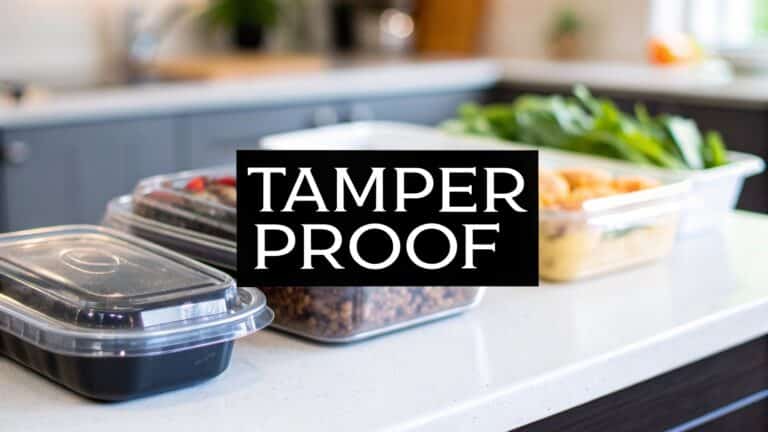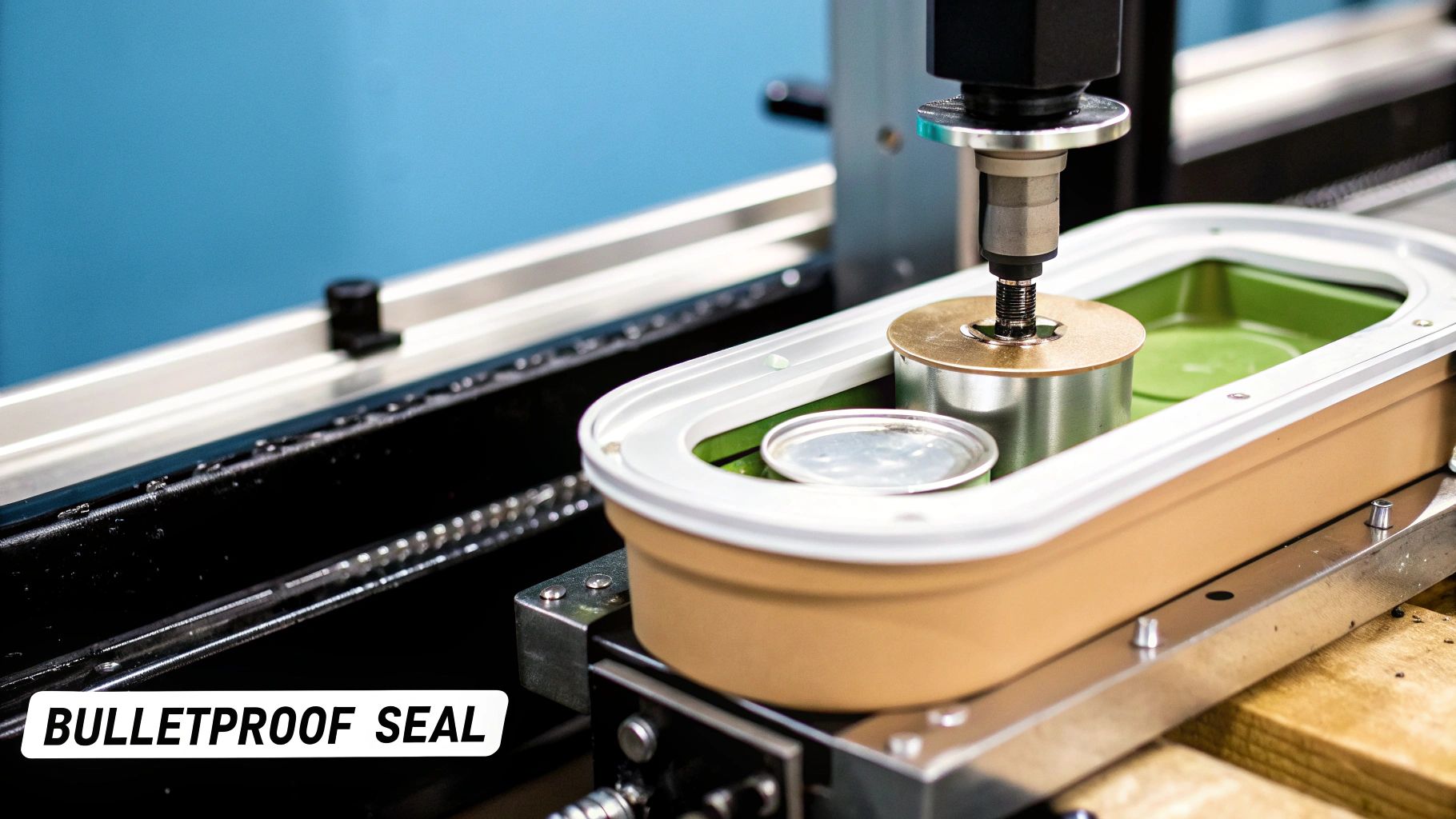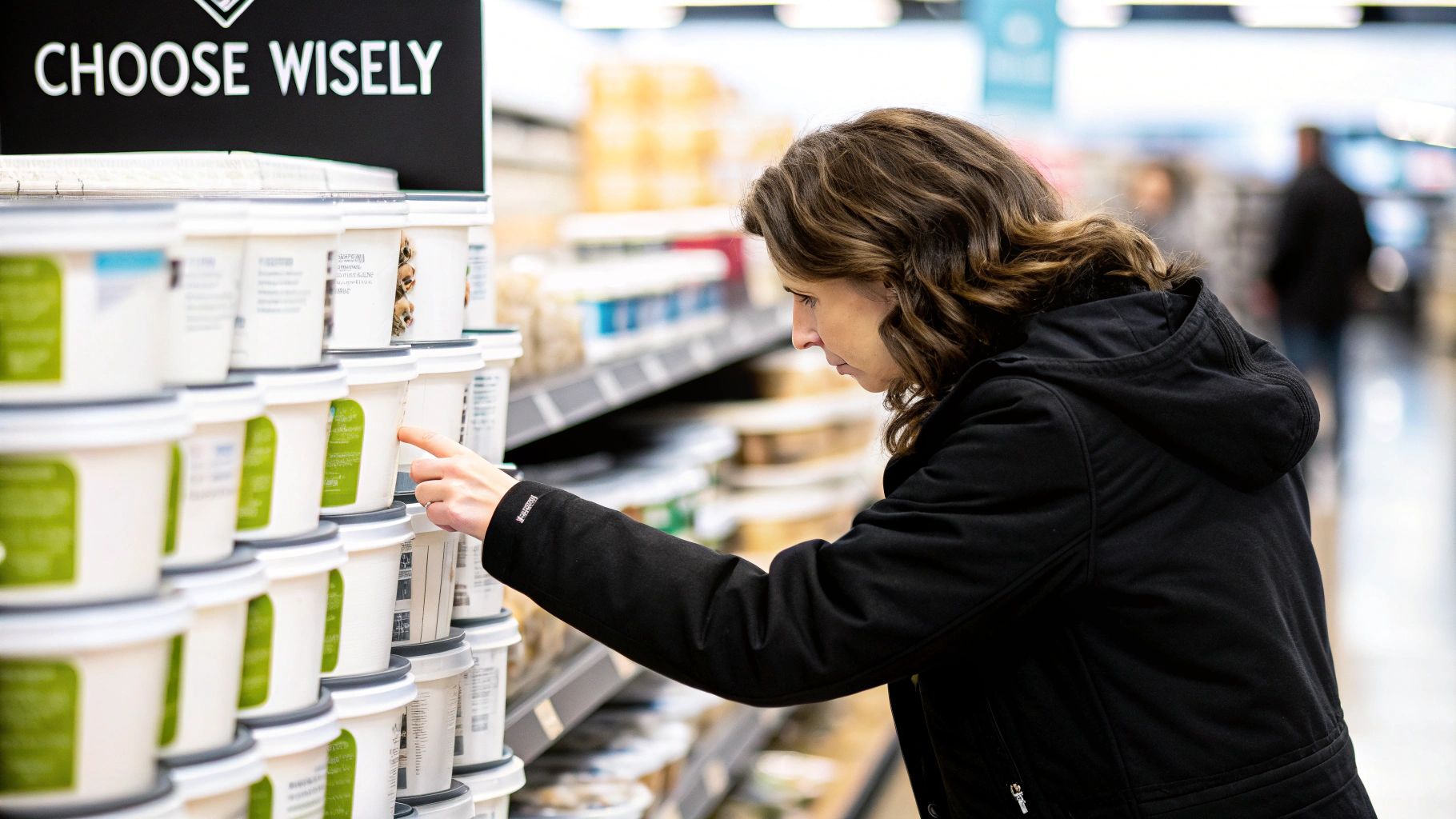The Real Impact of Tamper Proof Food Containers
Food safety is a major concern for today’s consumers. Tamper proof food containers have evolved from simple packaging to essential symbols of trust, primarily due to growing anxieties about food tampering and contamination. For businesses, prioritizing these security measures is crucial for maintaining consumer confidence and protecting brand reputation.
Building Trust Through Visible Security
A key aspect of tamper proof food containers lies in the difference between tamper-evident and tamper-resistant designs. Tamper-evident packaging offers clear visual cues if the container has been compromised. A broken seal or a raised tab immediately alerts the consumer, reassuring them about the product’s safety.
Tamper-resistant packaging, conversely, focuses on preventing tampering altogether with stronger materials and more complex closures. This proactive approach adds another layer of security, further bolstering consumer trust.
Protecting Against Contamination and Interference
Tamper proof containers serve as the first line of defense against both accidental contamination and intentional tampering. They protect food from spills and environmental factors during transport and storage. Furthermore, they deter malicious interference, safeguarding consumers from potentially harmful substances.
This dual protection is vital in today’s complex supply chains. The growing emphasis on food safety is reflected in the growth of the global tamper evident packaging market. Valued at approximately USD 2.2 billion in 2023, this market is projected to expand at a CAGR of 8.5% through 2032, driven by increasing consumer awareness of product safety and integrity.
Industry-Wide Implications
The rise of third-party delivery services like DoorDash and e-commerce platforms like Amazon has underscored the need for tamper proof packaging. As food passes through multiple hands, the risk of contamination or tampering increases significantly. This has led to a surge in demand for secure packaging solutions across the food industry.
From restaurants and catering services to grocery stores and meal kit providers, businesses are recognizing the importance of tamper proof containers. They are no longer a luxury but a necessity for building trust, maintaining a positive reputation, and, most importantly, protecting customers.
Security Features That Actually Work
Tamper-proof food containers are no longer just about keeping food fresh. They’re about building trust with your customers. But how do you choose features that really deliver on this promise? This section explores the mechanics of effective tamper-evident systems and how their design protects both consumers and your brand.
How Tamper-Evident Designs Enhance Security
Effective tamper-evident features offer immediate visual cues if someone has interfered with a container. Perforated breakaway components, for instance, leave undeniable evidence of opening. Heat-sensitive seals change color if tampered with. These designs deter potential tampering by making it obvious that any interference will be noticed.
This visibility also reassures consumers that their food has arrived untouched, reinforcing their trust in your brand. Clear signs of security translate to greater peace of mind for customers.
The Role of Materials in Tamper Proofing
The materials you choose significantly impact a container’s tamper-proof effectiveness. Durable materials like polypropylene create a robust barrier. However, the material must also be easy for consumers to open. No one wants to wrestle with their takeout container!
Finding the right balance between security and user-friendliness is key to a positive customer experience. This balance is at the heart of effective tamper-proof design.
To further illustrate the various materials and their applications, let’s examine the following table:
Tamper Proof Materials: What Works Where
| Material Type | Security Level | Environmental Impact | Cost Range | Ideal Applications |
|---|---|---|---|---|
| Polypropylene (PP) | High | Moderate (Recyclable, but can be energy-intensive to produce) | Moderate | Reusable containers, lids, tamper-evident bands |
| Polyethylene Terephthalate (PET) | Moderate | Moderate (Recyclable, but can contribute to plastic waste) | Low | Clear clamshells, beverage bottles, some tamper-evident films |
| Paperboard | Low to Moderate (Can be enhanced with coatings and tamper-evident seals) | Low (Biodegradable, recyclable) | Low | Takeout boxes, cartons, disposable containers |
| Aluminum | High (Difficult to tamper with without visible damage) | High (Recyclable, but energy-intensive to produce) | High | Foil seals, high-value food items |
| Bioplastics (PLA, PHA) | Moderate | Low (Compostable, bio-based) | High | Eco-friendly containers, films, and seals |
As the table shows, each material has its own set of advantages and disadvantages. Choosing the right material depends on the specific needs of your product and your brand’s sustainability goals.
Innovations in Tamper-Evident Technology
The tamper-proof packaging industry is constantly evolving, introducing new technologies that enhance both security and user experience. QR verification systems empower consumers to verify product authenticity using their smartphones. QR Code Generator offers solutions to create unique, trackable codes for product verification. Smart packaging, incorporating sensors, can detect tampering attempts in real time.
These innovations add another layer of security, especially important in today’s growing world of online food delivery.
The infographic above showcases a modern kitchen countertop stocked with transparent tamper-proof food containers, emphasizing secure storage as a top priority in today’s homes.
The clear containers and prominent “Secure Storage” message reflect the growing consumer demand for visible reassurance about food safety. This highlights the increasing importance of tamper-proof containers in building trust and confidence in the food we consume.
Why Tamper-Proof Food Containers Are Becoming Non-Negotiable
The food industry is experiencing a major shift. Tamper-proof food containers, once an optional extra, are now essential. Several factors are contributing to this change, from evolving consumer expectations to the growth of online food ordering. These forces are reshaping how we think about food safety.
The E-Commerce Boom and Its Impact on Food Safety
The rise of online food ordering and delivery presents new food safety challenges. As food travels through more complex distribution networks, the chances of tampering or contamination increase. This has led to a greater need for secure packaging. Restaurant chains and delivery services are now investing in tamper-proof containers to ensure food safety and build customer trust. This isn’t a passing trend; it’s a necessary adaptation to a changing food landscape.
Shifting Consumer Psychology: The Demand for Visible Security
Unfortunately, high-profile food tampering incidents have made consumers more anxious about food safety. This has led to a significant change in how people buy food. Consumers now actively look for visible security features on packaging. Tamper-proof containers not only protect food but also reassure customers about safety and quality, impacting brand loyalty. When choosing tamper-proof containers, businesses might want to consider the advanced features offered by suppliers of strong security doors.
Market Growth and Regional Trends
The rising demand for tamper-proof containers is reflected in market projections. The global tamper-evident packaging market is expected to reach USD 4.76 billion by 2034, up from USD 2.34 billion in 2025. That’s a projected CAGR of 8.22%. North America is currently the largest market, driven by strict regulations and high consumer demand for product safety. The Asia-Pacific region is showing the fastest growth, fueled by industrialization, urbanization, and growing awareness of safety concerns.
Industry Innovation and the Future of Food Packaging
Many companies are developing new tamper-evident technologies. These innovations, from basic break-away seals to advanced color-changing indicators, are raising the bar for food safety. These improvements offer greater protection and enhance brand reputation. This increased focus on security is transforming the food industry, shifting from simple packaging to integrated solutions that prioritize consumer safety and trust.
Navigating the Regulatory Maze for Tamper-Proof Packaging
The regulatory landscape for tamper-proof food containers is complex and ever-changing. Understanding these regulations is vital for businesses to safeguard consumers and maintain their reputation. This section clarifies key compliance requirements, offers practical advice, and examines emerging trends in tamper-proof packaging regulations.
Key Regulations in Major Markets
Different regions have distinct requirements for food packaging. In the United States, the FDA (Food and Drug Administration) establishes standards for food contact materials and tamper-evident features. These regulations strive to prevent contamination and guarantee consumer safety.
In Europe, the EFSA (European Food Safety Authority) provides similar guidelines for food packaging safety. These regulations prioritize traceability and transparency across the supply chain.
Designing for Compliance
Meeting regulatory requirements involves integrating specific design elements into your tamper-proof food containers. These may include:
- Tamper-evident seals
- Secure closures
- Special markings
For example, some regulations stipulate that containers must have a clear indicator showing if they have been opened. This might be a broken seal or a tab that is lifted when the container is first opened.
Furthermore, the materials used in the containers must adhere to food safety standards. This guarantees that the packaging itself doesn’t contaminate the food.
Implementing Compliant Systems
Companies that have successfully adhered to these regulations provide valuable insights. Effective implementation often includes:
- Rigorous testing protocols to confirm that packaging meets the necessary standards
- Meticulous documentation to demonstrate compliance with regulatory bodies and provide proof of due diligence
For instance, some companies perform regular audits of their packaging processes to ensure continued compliance. This could involve inspecting the integrity of seals, confirming the accuracy of labels, and examining documentation related to material sourcing and manufacturing processes.
Emerging Trends in Tamper-Proof Packaging Regulations
The regulatory environment is dynamic. Emerging trends include increased scrutiny of verification systems. This heightened attention arises from mounting concerns about counterfeiting and fraud. In the future, new benchmarks for authentication technologies may become standard practice.
Between 2020 and 2024, the tamper-evident packaging market value rose from USD 1.74 billion to USD 1.91 billion. This growth, driven by global anxieties around product safety, regulatory compliance, and counterfeiting, is expected to persist. In China, the market is projected to expand at a CAGR of 5% through 2035, fueled by strict packaging laws and escalating consumer demand. Similarly, countries like Spain have enacted rigorous regulations, advancing the implementation of tamper-evident solutions.
Staying abreast of these developments is critical for businesses to anticipate future requirements and adjust their packaging strategies accordingly. This proactive approach not only guarantees compliance but also cultivates consumer trust and protects brand reputation.
Turning Food Safety Into a Competitive Advantage
Tamper-proof food containers are no longer just about protecting food. They’re about protecting your brand. They’ve become vital business tools, significantly impacting consumer trust, loyalty, and, ultimately, your bottom line. This shift is fueled by growing consumer awareness of food safety concerns and the increasing demand for demonstrably safe products.
Building Trust and Loyalty Through Enhanced Security
Visible safety features on food packaging provide immediate reassurance to customers. Imagine receiving a takeout order with a clearly unbroken security seal. This visual cue instantly communicates care and attention to detail, fostering trust and encouraging repeat business. For example, some restaurants are using branded tamper-evident stickers as a mark of quality. They’re turning a safety feature into a recognizable symbol of their commitment to customer well-being. This simple step can significantly impact brand perception.
Reducing Liability and Preventing Costly Recalls
Tamper-evident packaging not only builds consumer trust but also minimizes business risks. By clearly showing if a product has been tampered with, these containers protect businesses from liability if contamination or product interference occurs. This extra security can potentially lower insurance premiums. Furthermore, by preventing contamination, tamper-proof containers significantly reduce the risk of expensive product recalls, safeguarding brand reputation and financial stability.
Tamper-evident packaging acts as a critical consumer protection tool by visibly highlighting product interference. Features like shrink-wraps, seals, and tamper-proof stickers offer significant business advantages, including enhanced brand reputation and consumer loyalty, and help companies comply with consumer protection laws. The presence of tamper-evident features reassures customers about product authenticity and quality, which is crucial in the fight against fraud and counterfeiting worldwide.
Cost-Benefit Analysis: Investing in Long-Term Protection
While there is an initial investment in tamper-proof packaging, the long-term benefits often outweigh the costs. Consider the expenses of a product recall: lost inventory, damaged reputation, and potential legal fees. Compared to the cost of tamper-evident containers, the investment in prevention becomes a strategic business decision. The increased consumer confidence and brand loyalty from visible safety measures can lead to higher sales and improved customer retention.
Streamlining Quality Control and Operational Efficiency
Advanced tamper-evident features contribute to more than just enhanced safety. They optimize quality control, especially within complex supply chains. By clearly indicating product integrity at each distribution stage, these containers help quickly pinpoint potential contamination or tampering. This allows businesses to address issues proactively, minimizing disruptions and boosting operational efficiency. Navigating the world of tamper-proof containers also involves understanding compliance. This proactive approach strengthens brand reputation, builds consumer trust, and contributes to a more secure and efficient business.
Balancing Security and Sustainability in Food Packaging
Tamper-proof food containers are vital for food safety, but their environmental impact is a growing concern. The good news is that innovation is bridging the gap, creating containers that protect both food and the planet. This reflects a broader move towards eco-conscious practices in the food industry.
Eco-Friendly Materials: Safeguarding Our Food and Our Future
Progressive brands are adopting new materials that offer both security and sustainability. Plant-derived polymers, for instance, provide a compostable alternative to traditional plastics. Ocean-bound plastic repurposes plastic waste from our oceans and coastlines, turning a pollutant into a valuable resource. Consumer demand for environmentally responsible options is fueling the growth of these materials.
Streamlined Design, Significant Impact
Minimalist designs contribute significantly to sustainability. Reducing excess packaging and streamlining container shapes minimizes material usage and waste. This approach prioritizes functionality while lessening environmental impact. For example, some companies are eliminating secondary packaging, like cardboard sleeves, while preserving the container’s security features.
To help illustrate the exciting developments in sustainable tamper-proof packaging, the following table showcases some of the latest innovations:
Next-Gen Sustainable Tamper Proof Solutions
| Container Type | Sustainable Materials | Security Features | Biodegradability | Current Applications |
|---|---|---|---|---|
| Molded Fiber | Bagasse (sugarcane fiber), Bamboo, Mushroom packaging | Tamper-evident seals, RFID tags | Fully compostable in industrial composting facilities | Ready meals, takeout containers, egg cartons |
| Bioplastics (PLA) | Corn starch, sugarcane | Tamper-evident seals, holographic labels | Compostable in industrial composting facilities | Yogurt cups, clear clamshell containers, beverage bottles |
| Seaweed-Based Films | Agar, carrageenan | Biodegradable seals, edible films | Fully biodegradable in marine and home composting environments | Snack packaging, sachets, single-serve portions |
| rPET (Recycled PET) | Recycled plastic bottles | Standard tamper-proof seals, shrink sleeves | Recyclable, but not biodegradable | Beverage bottles, food trays, clamshell containers |
This table highlights the diversity of sustainable materials and security features now available. It’s important to note that biodegradability varies depending on the specific material and composting conditions.
Consumer Preferences and Eco-Friendly Packaging
Consumer behavior is a driving force behind the shift towards sustainable tamper-proof solutions. Studies reveal that customers are more inclined to purchase products in eco-friendly packaging, even at a slightly higher price. This willingness to pay a premium reflects the growing consumer interest in sustainability. Brands prioritizing eco-conscious packaging are gaining a competitive edge.
Lifecycle Assessments: Evaluating Environmental Impact
Lifecycle assessments offer valuable data on the true environmental impact of various packaging options. These analyses evaluate the entire lifecycle of a container, from raw material extraction to disposal. This comprehensive approach allows businesses to make informed decisions about materials and design, reducing their environmental footprint.
Balancing Price and Values
Sustainable materials and manufacturing often lead to higher production costs. However, many consumers are willing to pay more for tamper-proof containers that align with their values. This creates an opportunity for businesses to demonstrate leadership in sustainability while meeting consumer demand. Striking a balance between premium pricing and perceived value is crucial.
The Future of Food Protection: What’s Coming Next
The world of tamper-proof food containers is constantly evolving. New technologies are reshaping food security, offering increased protection and transparency for consumers. This progress is fueled by advancements in material science, data analysis, and growing consumer demand for enhanced safety.
Smart Packaging: Real-Time Monitoring and Verification
Imagine a food container that tells you if it’s been tampered with. That’s the potential of smart packaging. NFC-enabled containers, for example, allow consumers to verify a product’s authenticity with their smartphones. NFC Technology uses near-field communication to exchange data between devices. A quick tap can confirm that the food hasn’t been compromised, offering an extra layer of security, especially important in the expanding world of food delivery.
Blockchain Technology: Unalterable Records of Authenticity
Blockchain technology provides another level of protection. It is a shared, immutable ledger that facilitates the process of recording transactions and tracking assets in a business network. By creating a permanent record of a product’s journey through the supply chain, blockchain can verify authenticity and identify potential tampering. This adds a new dimension to food traceability, increasing transparency and accountability.
Reactive Packaging: Visual Indicators of Tampering
Material science is also contributing to innovative solutions. Reactive packaging materials change color or texture when tampered with, providing immediate visual cues. These changes offer a clear signal of interference, boosting consumer confidence. For example, Novolex has introduced TamperFlag containers, featuring a built-in “flag” that pops up when opened, clearly indicating prior unsealing.
AI and Machine Learning: Predictive Protection
Artificial intelligence (AI) and machine learning are being employed to detect tampering attempts in real time. Artificial Intelligence and Machine Learning analyze data from the supply chain to identify patterns and anomalies that might suggest tampering. This proactive approach provides a new level of food protection, addressing potential issues before they affect consumers.
Meeting Consumer Demand: Transparency and Security
These advancements are not just about technology; they address evolving consumer needs. The growth of food delivery and e-commerce has heightened the demand for visible security features. Consumers want assurance that their food is safe. Tamper-proof containers offer that peace of mind.
By understanding and implementing these emerging trends, businesses can lead in food safety, protecting both their customers and their brand.
Ready to improve your food safety and build customer trust? Explore MrTakeOutBags.com’s selection of tamper-evident packaging solutions. Find the right packaging for your business today.







Comments are closed.